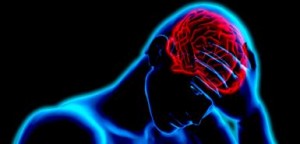 A network of emotion-regulating brain regions implicated in the pathological worry that can grip patients with anxiety disorders may also be useful for predicting the benefits of treatment.
A network of emotion-regulating brain regions implicated in the pathological worry that can grip patients with anxiety disorders may also be useful for predicting the benefits of treatment.
A new study appearing online today (Jan. 2) reports that high levels of brain activity in an emotional center called the amygdala reflect patients’ hypersensitivity to anticipation of adverse events. At the same time, high activity in a regulatory region known as the anterior cingulate cortex is associated with a positive clinical response to a common antidepressant medication. The study will appear in an upcoming issue of the American Journal of Psychiatry.
For individuals with anxiety disorders, the anticipation of a bad outcome can be worse than the outcome itself, says Jack Nitschke, assistant professor and clinical psychologist at the University of Wisconsin-Madison School of Medicine and Public Health and lead author of the new study. Some individuals spend so much time worrying about getting into a negative situation or having a panic attack, he says, that the condition becomes debilitating. “In an extreme situation, they might not even leave their home,” he says.
To study how the brain responds to anticipation, researchers at the UW-Madison Waisman Laboratory for Brain Imaging and Behavior used functional magnetic resonance imaging (fMRI) to examine patients with generalized anxiety disorder (GAD) as they viewed a set of negative and neutral images. Patients were shown pre-image cues several seconds before each picture so they would know what to expect: a circle before a neutral image and a minus sign before an aversive image.
While GAD patients showed no difference compared to healthy subjects in brain activation in response to the aversive or neutral pictures themselves, they displayed unusually high levels of amygdala activity in response to both anticipatory cues. According to Nitschke, the response suggests that the patients are hypersensitive to the anticipation of any stimuli, even those they are told will not be negative.
“In response to both of those anticipatory signals, the GAD subjects – the anxious folks – are showing huge amounts of amygdala activation that is much more than what healthy control subjects showed,” he says.
The researchers believe the high levels of amygdala activity seen in GAD patients reflects an indiscriminate and disproportionately large response to the idea that something negative might happen in the future, even in a lab setting where they know nothing bad will actually occur, he says.
“It suggests that there are differences in anticipatory brain processing in these individuals,” he says, adding that the result has important implications for other related disorders as well. “That’s the crux of what’s debilitating in people with anxiety disorders, whether it’s panic disorder, obsessive compulsive disorder or post-traumatic stress disorder.”
The patterns of brain activity also appear to hold predictive power for how patients will respond to treatment for their anxiety. After their brain scans, the GAD patients in the study received an eight-week course of treatment with venlafaxine (Effexor), a common antidepressant. Clinical improvement on the medication was associated with higher levels of pre-treatment brain activity in the anterior cingulate cortex (ACC) in anticipation of both aversive and neutral stimuli.
The ACC is a regulatory brain region important for modulating emotional responses. Activity in the same area has been shown to predict clinical outcome in patients with depression.
“When you look within the GAD patient population, that area is what predicts whether they respond to this treatment,” says Nitschke. “What it suggests is that people who still have some residual functioning of that area are the people who are more likely to get better” with this drug.
Choosing the most appropriate treatment approach for an individual patient is an important and difficult issue, he says, because anxiety disorders encompass a range of conditions with diverse symptoms and causes. Anxiety disorders are also frequently associated with depression, and Nitschke and his collaborators next plan to examine GAD patients with and without major depressive disorder.
“This is a critical new direction that the field is already moving in – using fMRI to predict treatment response,” he says. “Hopefully we’ll be able to use that eventually to determine what kind of treatment to provide to people.”
Source: University of Wisconsin-Madison
